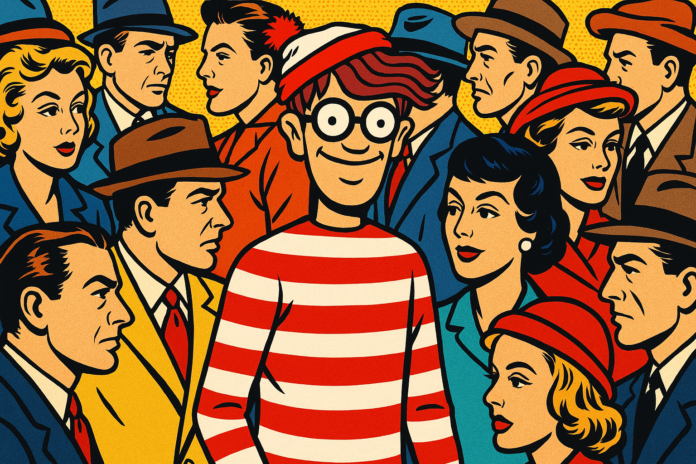by Sabrina Duse
Wally was never hiding. The red-and-white stripes, the pom-pom hat, the glasses that signal “studious but fun,” the cane that’s more affectation than necessity—this is not camouflage. This is spectacle. Wally wanted to be seen, and not just seen, but spotted, adored, triangulated across space and page by squinting children and nostalgic adults performing the labor of leisure. “Where’s Wally?” is a question that never needed to be asked; he was always right there, standing out like a socialist at Davos, patiently waiting for someone to do what he couldn’t bring himself to do alone: admit he wanted attention.
There’s something tragic in the performative humility of the archetypal hider. Wally presents himself as elusive, bashful, modest to the point of invisibility. But his very design contradicts this posture. His stripes are not the costume of the hidden, but the lure of the almost-found. He could have worn beige. He could have crouched behind a dumpster or blended into a crowd of actual background characters—gray-faced, same-suited, name-tagged extras in the bureaucracy of illustrated anonymity. But no. He dressed like a Parisian mime in heat, then planted himself in a medieval festival or a robot factory or a zombie apocalypse, hoping your gaze might wander his way.
You can imagine him in a therapist’s office, twiddling his fingers over his red knee socks. “I don’t know why no one ever really sees me,” he’d say, though his entire aesthetic screams look at me. He’s the child of a thousand middle-class aspirations: the desire to stand out just enough, but not too much; to be recognized, but only if you work for it; to be exceptional, but within the bounds of politeness and game design. His whole saga is one of bourgeois contradiction. The joy of being found, but only if it’s earned. The thrill of hiding, but never too well.

Wally is a walking paradox, if seen through the lens of philosophy. In the existentialist sense, he is both project and object, a self that wants to be both singular and subsumed. Sartre might call him a bad-faith wanderer—fleeing freedom under the guise of leisure. He moves across time and space not to escape being seen, but to defer the confrontation with the void of being unseen. He hides, but not so well that you won’t eventually find him. He wants you to try, but not too hard. He lives in the conditional tense of attention: if you notice me, I will have mattered.
Wally doesn’t hide from you. He hides for you. And in doing so, he reveals more about us than about himself. We need him to be hiding so that we can become the finders. Children crave the discovery. Adults crave the nostalgia of it. He exists to enable the brief illusion that the world is an orderly place, a finite field in which every mystery can be solved with patience, diligence, and 20/20 vision. In Wally’s universe, chaos is ornamental, not structural. You’ll always find him. You just have to look long enough. It’s a lie, of course, but a seductive one. A kind of secular grace.
And what’s the cost of that lie? Not much, you’d think. But consider what it teaches: that those who want to be found will wear stripes. That visibility is the reward for charm and consistency. That if someone hasn’t been spotted, maybe they’re not trying hard enough. Maybe they should have dressed differently. Maybe their obscurity is a choice. The Wally logic flattens the politics of presence. It disguises attention as meritocracy. It makes seeking feel democratic, but the field was rigged from the start. He was never going to be where the brown dog was. He wasn’t the old man on the bench. He was Wally. Always center-left, two-thirds down the page.

There’s also something oddly clerical about Wally—his red and white like liturgical vestments, his staff like a bishop’s crozier. He’s a seeker who wants to be sought, a pseudo-saint of the secular gaze. We carry the book like a devotional object, flipping pages like scripture, scanning the margins for signs of his passing. And when we find him, there is a flash of joy, a spike in dopamine, a low-stakes triumph in a world increasingly devoid of clear victories. “There you are!” we say, as if the relief of seeing him means we’ve seen ourselves. In truth, we’ve only confirmed the rules of the game. He will be there. You will find him. It’s designed that way.
But what if one day he wasn’t? What if you turned the page and he wasn’t in it? What if the crowded beach or the intergalactic conference hall just… didn’t contain him? Would you feel panic? Rage? Betrayal? Or just the deeper sorrow that comes from realizing you’ve been performing a ritual, not engaging in a search? Wally always wanted to be found, but maybe we needed him to want it. Maybe that was the real trick. Not hiding. Not finding. Just believing that someone out there was wearing stripes for our benefit.
Wally is both the fantasy of being seen and the labor of seeing. A fable for the attention economy before we had the vocabulary. He was the influencer before the feed. The red-hatted prophet of a world where visibility substitutes for connection and discovery stands in for meaning. He’s still standing there, patient, wide-eyed, waiting to be found again and again and again. Like all of us, really. Only better dressed.
